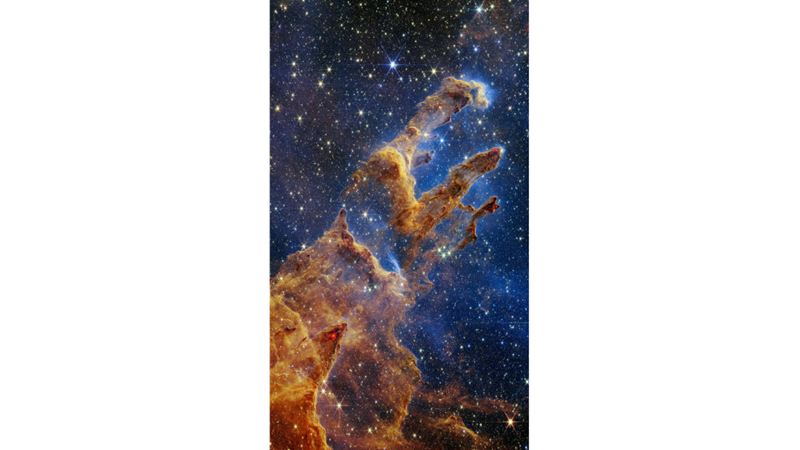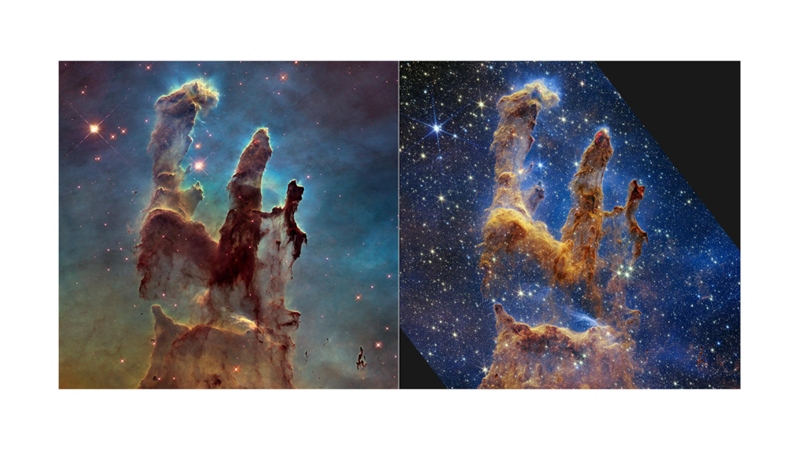NASA's James Webb Space Telescope transforms a near-infrared image of the Pillars of Creation into a riot of colour. Although these pillars look like giant arches and towers rising from a desert landscape, they are actually filled with translucent gas and dust and are in constant transformation. This is an area where young stars are forming or still emerging from dusty cocoons.
This observation by the James Webb Space Telescope reveals a rich and detailed scene within these dense clouds of gas and dust where new stars are forming. The three-dimensional pillars look like imposing rock structures, but they are highly permeable and composed of cold interstellar gas and dust. This dust sometimes becomes translucent in infrared light.
These iconic structures were first imaged by NASA's Hubble Space Telescope in 1995, but new Webb images allow scientists to more precisely determine the amount of gas, dust and the number of newborn stars in this region. This will enable the development of more comprehensive models of how stars form and evolve from these dusty clouds over millions of years.
In this image, taken with Webb's Near Infrared Camera (NIRCam), newly formed stars are the centre of attention. These bright red orbs, often with diffraction spikes, are located in the area just outside one of the columns. When the nodes reach sufficient mass within the columns of gas and dust, they begin to collapse under their gravity, heating up and eventually giving birth to new stars.
But what do the wavy lines on the edges of the pillars, resembling lava flows, signify? These are eruptions of gas and dust from stars still in the process of formation. Young stars eject jets at supersonic speeds that collide with clouds of material. These collisions can cause bow shocks, like the wave trails left by a boat as it travels through the water. The reddish glow is caused by hydrogen molecules whose energy is released during these jets and collisions. This activity is clearly visible in the second and third columns from the top, and the images captured by NIRCam reveal their energetic activity. These young stars are estimated to be only a few hundred thousand years old.
Thanks to near-infrared light, Webb seems to reveal cosmic distances behind the clouds, but almost no galaxies are visible in this image. This is because the dense mixture of interstellar gas and dust in the Milky Way's disc greatly obscures our view of deeper parts of the universe.
This region was first imaged by the Hubble Space Telescope in 1995 and re-examined in 2014. Many other observatories have also focused on this region. With each new technology, new information about this star-filled region becomes available to researchers.
This close-up image shows part of the vast Eagle Nebula, 6,500 light-years away.
Are you ready for an interesting information about these beauties known as the Towers of Creation or Pillars of Creation? Actually, they disappeared for 6 thousand years. But since they are 7 thousand light years away from us, we will see their extinction after a thousand years. How do we know they disappeared if we didn't see them? Because we saw the supernova that caused their extinction.
Isn't that interesting? It's like time travelling!
Credits:
NASA, ESA, CSA, STScI; Joseph DePasquale (STScI), Anton M. Koekemoer (STScI), Alyssa Pagan (STScI)


 Nielawore
Nielawore










Yorumlar
sanki bir el uzanıyormuş gibi yukarıya
Çok ilginç
Bana atlar şaha kalkmış gibi geliyor
Yorum yazmak için lütfen giriş yapınız